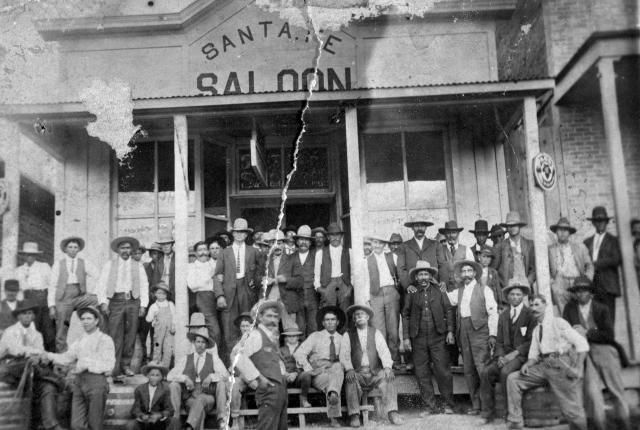Editor's Note: Just over a week after we went to press with the November issue, the owners of the St. James Hotel announced on Facebook that the historic Cimarrón property was closing on September 17. Read Will Grant's "Ode to the St. James Hotel" for a tribute to the lodging house, its bullet holes, and the spirits who reportedly walk its halls.
THE SALOON in the St. James Hotel, in Cimarrón, feels like an art gallery of the Old West. Bridle bits, spurs, and old rawhide riatas hang in glass cases on the walls. A heavily used saddle sits on a stand beside the upright piano. A long bar runs the length of one wall, and the backbar is a mirror framed by dark, ornately inlaid hardwood of a type not easily found in New Mexico.
As you walk across the barroom, the floorboards creak and moan in ways likely unchanged since the saloon first opened in 1872. It’s the kind of place where you might expect Buffalo Bill Cody to step through the door—partly because he did.
The St. James hosted some of the most famous and infamous characters of the West. Buffalo Bill, Wyatt Earp, Jesse James, Billy the Kid, Pat Garrett—they all stayed at the hotel. Key tags used by some of the most notable guests are displayed in the lobby today. They attest to the lodging house’s reputation of offering the best food, drink, and accommodation of any place within a week’s ride of Cimarrón and the nicest spot on the western half of the Santa Fe Trail. Founder and proprietor Henri Lambert, a French immigrant who was also the hotel chef, became famous for his sherry pork tenderloin and pureed carrots. Like many beer-and-whiskey joints throughout the developing West, the St. James Hotel and its saloon filled a societal role as a gathering place that can still be experienced throughout New Mexico.
The St. James saloon, now called TJ’s Bar, occupies the same footprint as Lambert’s original building. In a small room behind the bar that was once used as a private gaming room, the original adobe bricks are visible in a cutout section of the wall that’s like a window into history. The roulette table, now faded and protected by a sheet of Plexiglass, is also original. So, too, are the 26 bullet holes in the pressed tin ceiling.
“You’re looking at the newer ceiling that was put in in the early 1900s,” says Thea Maestas, front desk manager for the St. James Hotel. “There’s evidence of over 300 bullet holes in the old ceiling above it.”
The St. James is not alone in bearing evidence of indoor gunfire. Bullet holes are a necessity for any saloon claiming Old West heritage, according to Melody Groves, author of Hoist a Cold One!: Historic Bars of the Southwest (University of New Mexico Press, 2011). She saw plenty of pockmarks while researching her book, which took her to the back corners of New Mexico, Colorado, Arizona, and Texas. While the design and construction of saloons varied in the early West, Groves notes, the one requirement to doing business was the actual bar. “The saloon was the social gathering point in the West—like the newspaper of the day—and the anchor of the saloon was the bar,” she says.
The first saloons in what would become New Mexico were cantinas, established by the Spanish. Rough-hewn cottonwood planks laid over barrels or crates sufficed to serve early patrons. As the population grew, so too did the level of hospitality. Doors and wagon beds replaced the planks. Advancements like the railroad and refrigeration significantly changed the operation and offerings of saloons.
The bars themselves became more refined and grandiose. The majority of those in the West, including the one in the St. James, were made from eastern hardwood by the Brunswick-Balke-Collender Company in Cincinnati. These large, heavy bars were built and carved by Italian woodworkers and then shipped west on the railroad. Once assembled and open for business, the saloon became the hub of the immediate community, a place not only to get food and drink but also find a job, conduct trade, and even get married.
“There’s a beautiful transformation of the American West that can be seen in these bars,” Groves says, “from instability to towns and societies and permanence—and the bars reflect that.”
Most of the old saloons in New Mexico exist in the same form and function as they originally did. These places are a testament to the art and science of bringing adobe-timber-frame structures up to code and into the 21st century. While many survive, it’s shocking more haven’t burned down. Less surprising is that many are riddled with bullet holes. But what’s remarkable about them is their ability to bring the past into focus. At the Laguna Vista Saloon, in Eagle Nest, you can still tie up your horse to the hitching post out front. At the Hotel Eklund, in Clayton, you won’t find any barstools because the original was a stand-up bar, and that’s how the owners have kept it. At the St. James, the lace curtains, 19th-century furniture, and long, polished wood bar transport patrons to the same place at another time.
That’s also true for the relative newcomers. The Los Ojos Saloon, in Jemez Springs, for instance, has been a center of the small community (population: 250) since it opened in the 1940s. Multiple generations of families have sat at the bar and worked in the kitchen, waited tables, or poured drinks. The people who tend bar and the patrons who sit there, year after year, have infused the special character of these spots.
“Instead of someplace to just go get a drink, when you’re in these places, you’re in the middle of history,” Groves says. “They’re special, they’re treasures of the state, and each one has a unique story.”





